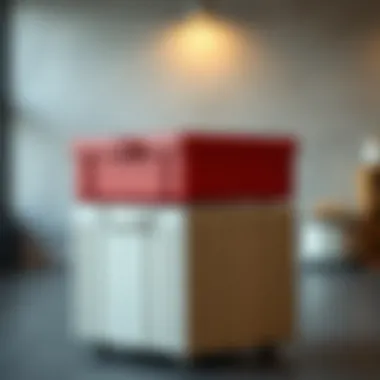Mastering the Art of Recycling Storage Containers


Intro
Recycling storage containers isn’t merely a matter of reducing waste; it's about breathing new life into something that would otherwise be discarded. In our fast-paced society, where convenience often trumps sustainability, it’s easy to overlook the potential locked away in old containers. However, savvy homeowners and DIY enthusiasts have started to see these everyday items as gold mines of opportunity.
When looking at storage containers, we can think of them not just as receptacles for clutter but as canvases for creativity and sustainability. Embracing the philosophy of repurposing not only enhances the organization of our spaces but also serves a greater purpose in tackling the environmental challenges we face. In this guide, we’ll explore various ways to recycle storage containers, innovate in their use, and tap into the aesthetic side of home organization.
For homeowners, designers, and DIY enthusiasts alike, the practical aspects of recycling storage containers can provide refreshing insights into both organization and sustainability. By digging deep into the heart of this subject, we can cultivate a mindset where recycling and home aesthetics align seamlessly.
Let’s embark on a journey to unlock the hidden potential of storage containers and transform them into practical, stylish, and sustainable pieces of our homes.
Preface to Recycling Storage Containers
In today's world, the act of recycling transcends mere obligation; it's a lifestyle choice that directly impacts the environment. Recycling storage containers offers a practical avenue to promote sustainability, and this section will explore why understanding this art can make a difference in household organization and contribute to global efforts to minimize waste.
As we dive into the discussion, it's imperative to recognize that recycling is only one facet of a multifaceted solution to the challenges posed by excess waste. These storage containers, found in various forms across our homes, can be repurposed and reused, effectively reducing the overall amount we throw away. This not only alleviates pressure on landfills but also conserves valuable resources—all while providing practical benefits for those who choose to engage in such practices.
The journey to effectively recycling storage containers begins with a firm grasp on what these containers are and how they function in our daily lives. From the multi-purpose plastic bins housing forgotten summer clothes to the glass jars once filled with preserves, nearly every household has an arsenal of storage solutions waiting for a new function.
This guide aims to equip readers with insights into the various types of storage containers, their potential uses, and practical tips to streamline the recycling process. The benefits are manifold:
- Environmental Impact: Every item recycled is one less in landfills.
- Cost Efficiency: Repurposing containers can save homeowners money that might be spent on new storage solutions.
- Creative Expression: Transforming old containers into useful or decorative items encourages creativity.
By the end of this article, audiences—from homeowners to designers—will gain a comprehensive understanding of how recycling storage containers not only aids personal organization but also contributes to a broader narrative of sustainability. Whether you're a seasoned recycler or a novice, there's something to be gleaned from this exploration into the art of recycling storage containers.
Types of Storage Containers Suitable for Recycling
Recycling isn't merely about tossing items into the blue bin. It stretches further, particularly with storage containers, which can be an underappreciated asset in sustainable living. Understanding the types of storage containers that can be recycled is pivotal for any homeowner who’s eager to reduce waste and embrace a greener lifestyle. Let's delve into the particular categories and why they matter when considering ways to minimize our environmental footprint.
Plastic Containers
Plastic containers are everywhere, from your favorite snack jars to laundry detergent bottles. Their versatility makes them prime candidates for recycling. However, not all plastic is equal. Generally, storage containers made of high-density polyethylene (HDPE) and polypropylene (PP) are the most commonly recycled.
- Benefits: These plastics can be transformed into new containers or even textile fibers, contributing to a circular economy.
- Considerations: Before recycling, ensuring they're clean and free from food residue is crucial. Otherwise, contamination issues can lead to these containers being tossed in the trash, instead of the recycling bin.
Glass Jars
Glass jars, often utilized for food storage or even DIY projects, are another excellent option for recycling. Not only are they durable, but they also don’t leach harmful substances like some plastics may do. When sorted properly, glass is infinitely recyclable.
- Benefits: This means significant reductions in landfill waste and decreased resource extraction for new glass production.
- Considerations: Different colored glass containers should be sorted during recycling. Clear, green, and brown glass are typically processed separately to maintain quality in new products.
Metal Tins
Metal tins, including soup cans and beverage containers, also deserve a spotlight. These materials have a high recycling rate. Most cans are made of aluminum or steel, both of which can be melted down and reformed without losing quality.
- Benefits: Recycling metal helps in preserving raw materials and energy. For instance, recycling aluminum saves about 90% of the energy required to make new aluminum cans from bauxite.
- Considerations: Before tossing them out, it’s best to rinse and remove lids to avoid contamination with other materials.
Cardboard Boxes


Cardboard boxes are more than simple packaging. They can be recycled effectively, transforming them into new boxes or paper products. Given their biodegradable nature, they have a minimal environmental impact compared to plastics and metals.
- Benefits: They contribute to resource conservation and reduce the need for timber, as recycled cardboard can be converted back into high-quality paper.
- Considerations: However, for best results, wet or greasy boxes shouldn't be recycled. Keeping them dry and clean is key to ensuring they can be salvaged during the recycling process.
Understanding these various storage containers and their recycling viability is a vital step for homeowners and enthusiasts keen on making a difference. By being mindful of what types of containers we are using and how we can recycle them, we are positioning ourselves as responsible stewards of the environment, inching closer to a sustainable future.
Innovative Ways to Repurpose Storage Containers
When it comes to recycling, we often think about the end product—how we dispose of plastic or glass—but there’s a whole lot of creativity involved in repurposing those old storage containers that can add flair to our homes. Repurposing storage containers isn't just beneficial for the planet; it also inspires ingenuity in home organization, decoration, and functionality. Utilizing such containers in innovative ways can help maximize their potential while minimizing waste, giving homeowners an opportunity to express themselves through creative projects.
Home Organization Solutions
Creating an Efficient Storage System
A well-structured storage system is one of the cornerstones of an organized home. Creating an efficient storage system using recycled containers can make finding what you need a breeze. By categorizing items into specific containers, you reduce clutter and save time. The key characteristic of this approach lies in the versatility of containers; plastic bins, metal tins, or even cardboard boxes can be transformed into robust organizational tools.
The unique feature of this method is its adaptability. For example, each family member can have their own container for personal items, or you can dedicate specific containers for seasonal decorations. This helps keep everything in its place. However, one downside is that certain materials, like cardboard, may not withstand long-term use if exposed to moisture. Thus, choosing the right type of container based on your intended use is crucial.
Segmenting Spaces with Containers
Segmenting spaces can significantly enhance functionality in homes—especially small ones. Using various containers to define specific areas, like a reading nook or crafting corner, gives structure without the need for permanent alterations. This clever use of containers offers a beneficial choice for those who like to keep their options open.
A notable characteristic of segmenting spaces is its ease of rearrangement. You can quickly shift things around without heavy lifting or renovation mess. The unique feature of this technique is how it imparts a sense of order to otherwise chaotic spaces. Still, if not done thoughtfully, it can lead to visually overwhelming layouts, so balance is essential.
Decorative Uses
DIY Planters from Containers
Turning old storage containers into DIY planters is a fantastic way to bring life to both indoor and outdoor spaces while recycling. The contribution of this project to your goals of sustainable living is twofold—it beautifies your home and promotes greenery, which is great for the environment. The key characteristic of DIY planters is their customization; you can paint, decorate, or leave them raw for a more rustic look.
What makes this approach unique is the ability to choose containers of various shapes and sizes, which can enhance visual interest. On the downside, not all materials are suitable for plant growth. For instance, metal containers can get hot, which may affect the soil and roots. To mitigate this, ensure proper drainage and use insulated linings when necessary.
Craft Projects with Recycled Materials
Utilizing storage containers for craft projects is another creative avenue. Not only does it minimize waste, but it also offers children and adults alike numerous opportunities for creative exploration. The key characteristic here is the unlimited potential for crafting; from decorative boxes to wall art, the only boundary is your imagination.
This feature is particularly appealing since you can tailor projects based on availability and need, making it an eco-friendly and fun option for gifting. However, crafting can often lead to a backlog of unfinished projects, so establishing clear, manageable goals at the outset helps prevent overwhelm.
Functional Alternatives
Using Containers for Art Supplies
Utilizing storage containers to organize art supplies is an efficient way to keep everything easily accessible while reducing clutter. This is especially important for artists of all levels, from hobbyists to professionals. The strength of this method lies in its practicality; containers can be sorted by the type of supply or the project theme.
Moreover, a unique feature of this approach is how it encourages habit formation. When everything has a designated spot, it becomes easier to develop a consistent workflow. However, if containers are too small or poorly labeled, it can lead to confusion rather than clarity. So, ensure that your chosen containers match the volume of supplies you possess.
Crafting Customized Gift Boxes
Creating personalized gift boxes out of storage containers adds a thoughtful touch to gifting. This approach not only recycles materials but also lets you put a personal spin on your presents. The distinct advantage of using storage containers is the variety of sizes and shapes available, making it possible to cater to different gifts elegantly.


The unique aspect of custom gift boxes is their ability to showcase creativity and thoughtfulness. There’s something special about opening a beautifully decorated recycled box that reflects the receiver's interests. However, the challenge lies in ensuring that the finish remains aesthetically pleasing, which can involve a bit of additional effort in decoration. Knowing your recipient is key to a successful project.
Repurposing storage containers offers practical solutions that benefit both the environment and your home organization. It's a win-win situation every way you look at it.
Overall, the innovative ways to repurpose storage containers provides far-reaching benefits, enhancing aesthetic appeal, functionality, and sustainability in your home.
Practical Tips for Recycling Storage Containers
Recycling storage containers can be a straightforward process when you know how to approach it. Understanding the right techniques and methodologies can transform simple tasks into sustainable practices. Homeowners often overlook the potential of storage containers, yet they play a crucial role in effective organization and environmental stewardship. Practical tips, in this case, serve not merely as instructions, but as guidance for optimizing both utility and sustainability. With the right knowledge, every container can find a new life, preventing waste and fostering creativity. Here are some detailed considerations to keep in mind:
Cleaning and Preparing Containers
Before repurposing any storage container, cleaning is paramount. Containers—be it plastic, glass, or metal—can harbor leftover residues that might not only be unappealing but can also diminish their new purpose. To start:
- Remove Labels and Stickers: These can be surprisingly stubborn. Soak the container in warm soapy water to help loosen the adhesives.
- Thoroughly Wash Containers: Use a mild detergent and warm water, ensuring all residues, scents, or grime are gone. For stubborn stains, a mixture of baking soda and vinegar can act as a natural cleaner.
- Dry Properly: Air drying can prevent moisture from becoming a breeding ground for mold. If quicker results are needed, a lint-free cloth can come handy.
Taking time to clean ensures bins are safe, functional, and aesthetically pleasing when placed back into use.
Choosing Suitable Containers
Not all storage containers are created equal, and selecting the right ones for your needs hinges on understanding their materials and conditions. Consider these factors when choosing:
- Material Durability: For instance, opting for thicker plastic over thinner variants can be beneficial for stability and longevity.
- Size and Dimensions: Assess your space! A snug fit within shelves can maximize efficiency. Sometimes small braids can be stacked for space-saving solutions.
- Style and Aesthetic Needs: Your decor reflects personal choices. Choosing containers that align with your home’s style can add to its overall charm. Wooden boxes for a rustic look, or sleek metallic designs for a modern vibe, all options have their place.
By being meticulous in selecting the right containers, one can ensure they meet both functional and aesthetic requirements.
Storage and Accessibility
Effective organization is key to making the most out of any storage solution. Here are some tips to consider:
- Strategic Placement: Position frequently used containers within easy reach. Reserve those used less often for higher or more remote spaces.
- Labeling: Clear labeling can save time and confusion. Simple labels made from recycled paper and tied with twine can strike a balance between functionality and style.
- Grouping Similar Items: Keep like items together. This not only saves time but also declutters spaces. For example, craft supplies should be stored in one area, while seasonal items can occupy another section.
When thoughtful storage and accessibility plans come into play, the organization takes less time and becomes more enjoyable to maintain.
"Sustainable practices begin at home. It is our small efforts combined that make a big impact."
Environmental Impact of Recycling
Recycling storage containers holds immense significance in the sustainable practices we adopt today. Not only does it reduce waste and promote resource conservation, but it also shapes a cleaner environment for future generations. Every time a container, be it plastic or metal, is recycled instead of tossed in a landfill, we make a conscious choice to nurture our planet. Such decisions resonate with the principles of sustainable living, enhancing our homes and communities one step at a time.
Reduction of Waste
Waste management is a pressing global issue. Statistics suggest that billions of tons of waste pile up in landfills every year, posing threats to ecosystems and human health. By prioritizing the recycling of storage containers, homeowners and organizations can play their part in mitigating this problem.
- Less Landfill Space Used: When we recycle containers, we help reduce the volume of waste. If more people engage in recycling efforts, the burden on waste disposal sites diminishes significantly.
- Lower Greenhouse Gas Emissions: The journey of disposal often leads to higher greenhouse gases as materials decompose. Recycling cuts down on the emissions generated during this process.
- Encouragement of Circular Economy: By recycling storage containers, we foster an economy where materials are reused and repurposed instead of being thrown away. This creates a system where resources maintain their value.
As homeowners recognize the ripple effects of their recycling habits, the collective effort becomes powerful. Every container recycled contributes to a cleaner environment, reducing pollution and promoting a sense of community responsibility.
Resource Conservation


Conservation of resources emerges as another crucial aspect of recycling storage containers. We often take natural resources for granted, but the reality is, they are finite and require careful stewardship.
- Saving Raw Materials: Recycling reintroduces materials back into the production cycle, which means fewer raw materials are needed. For example, recycled plastics can replace virgin plastic in various applications, saving oil and gas.
- Energy Efficiency: The energy required to recycle materials is often less than that needed to create new products from raw resources. For instance, recycling aluminum cans saves 95% of the energy needed to manufacture new cans from bauxite ore. This lower energy consumption translates to fewer fossil fuels burned and a smaller carbon footprint.
- Water Conservation: Manufacturing new products can consume significant amounts of water. When recycling initiatives are adopted, less water is used in the production process, further preserving this invaluable resource.
In light of all these factors, it becomes clear that recycling storage containers play a dual role: it addresses immediate waste management issues while also underscoring the broader implications for resource conservation. The art of recycling is not just about containers but about fostering a mindset that prioritizes sustainability at every level.
"It is not enough to look at recycling as an isolated act; it is part of a larger story about how we view our relationship with the Earth."
Approaching recycling as a routine part of our lives leads to a more sustainable future. Homeowners, designers, and DIYers stand at the forefront of this movement, encouraging one another while transforming everyday practices into lasting environmental impacts.
The Future of Sustainable Storage Solutions
In the journey towards a more sustainable lifestyle, the future of storage solutions is poised to become increasingly innovative. As homeowners and designers seek to reduce waste and increase efficiency, the concept of recycling storage containers has taken on new dimensions. It's not just about reusing items but also about adapting them to modern taste and functionality. This section delves into what this future holds, focusing on emerging trends and the evolution of furniture design to incorporate more recycled materials.
Emerging Trends in Recycled Materials
In recent years, there's been a noticeable shift not only in how we view waste materials but also in how we leverage them for practical use. One such trend is the integration of recycled plastics in everyday items, which has grown exponentially. These materials are becoming staples in creating eco-friendly storage options that appeal to a broad audience. For instance, furniture made from plastic bottles is becoming trendy.
- Sustainability in Design: Designers are increasingly prioritizing sustainable sourcing, seeking materials that minimize the ecological footprint. For example, products made from reclaimed wood or recycled metal are hitting the market. These materials not only contribute to sustainability but also provide unique aesthetic qualities, making them highly sought after.
- Versatile Applications: Recycled materials are being utilized in unexpected ways—from storage containers that double as decor, to functional pieces like benches or side tables constructed from repurposed crates. These innovations allow for creative expression while supporting environmentally conscious choices.
"Recycling isn’t just about collecting your plastic bottles. It’s about rethinking what those materials can become."
Above all, these trends highlight a growing awareness and responsibility towards the environment. With more brands committing to sustainability, consumers can now make choices that support a circular economy.
Innovations in Furniture Design
Furniture design is being revolutionized by the creative use of recycled storage containers. Designers aim to harmonize style with functionality, and this is vividly seen in several fresh design concepts that breathe new life into old materials. Given this, the implications are broad:
- Modularity and Customization:
- Aesthetic Appeal:
- Functionality with Eco-Consciousness:
- Innovative designs often focus on modularity, allowing users to create personalized storage solutions. For instance, systems that can expand or contract based on the user’s needs contribute to efficient space usage.
- The appearance of recycled storage containers has evolved. No longer characterized by a rough or utilitarian aesthetic, contemporary designs embrace sleek lines, colorful finishes, and tangible textures that can elevate any living space with character.
- Designers are keen to ensure that functionality does not negate sustainability. By creatively combining materials, multi-functional furniture pieces that serve both aesthetic and practical purposes are emerging. For example, a coffee table made from reclaimed wood with hidden storage compartments.
Such innovations are not merely about aesthetics; they reflect a larger movement toward a circular economy where materials are reused and repurposed, effectively reducing waste.
By harnessing these emerging trends and innovations in design, the future of sustainable storage solutions is bright. With each new development, we are reminded that creativity and sustainability can go hand in hand, ultimately leading to a better environment and an enhanced living space.
End
The exploration of recycling storage containers brings to light the significant role they play in upholding sustainable living practices. Understanding how to recycle these containers goes beyond merely reducing waste; it involves a conscious effort to alter perceptions regarding consumption and resourcefulness in daily life. Homeowners, designers, and DIY enthusiasts can find immense value in repurposing these items, leading to both functional benefits and aesthetic enhancements in home environments.
Summary of Key Points
- Environmental Responsibility: By recycling storage containers, individuals actively contribute to minimizing landfill waste and reducing their ecological footprint.
- Versatile Repurposing: Containers made from various materials—like plastic, metal, glass, and cardboard—can serve an array of purposes, ranging from organizational tools to decorative pieces.
- Cost-Efficiency: Utilizing recycled containers can substantially lower the costs associated with home improvement projects. Instead of purchasing new storage solutions, one might breathe new life into items that would otherwise be discarded.
- Creative Expression: Engaging in the transformation of storage containers allows for creativity and personal flair in home decor, combining practicality with individual style.
- Sustainable Practices: The adoption of sustainable practices within homes promotes a broader collective effort towards environmental stewardship.
Call to Action for Sustainable Practices
As we wrap up this discourse on recycling storage containers, the call to action echoes loudly. It is high time we take responsibility for the sustainability journey of our homes. Here are some actionable steps to consider:
- Assess Your Container Usage: Take stock of the storage containers currently in your home. Identify which can be reused and transformed for different purposes.
- Educate Others: Share your recycling journey with friends, family, and neighbors. Encourage them to adopt similar practices by showcasing the benefits you've experienced.
- Dive into DIY Projects: Explore creative DIY projects that utilize your recycled containers. From storage solutions to artistic installations, the possibilities are boundless.
- Stay Informed: Regularly check governmental and nonprofit resources on recycling practices. Websites like EPA.gov provide up-to-date information on sustainable practices and recycling guidelines.
- Engage with Social Communities: Join platforms like Reddit or Facebook groups centered around sustainability and recycling. Engage in discussions, share your ideas, and learn from others who are on the same journey.
The world is in dire need of more environmentally conscious choices, and small steps can lead to substantial changes. Embrace the art of recycling storage containers and inspire others to join the movement.















